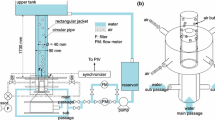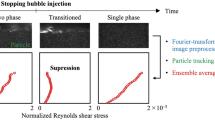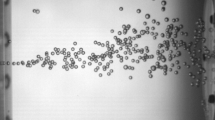Abstract
Our previous study showed that the frictional drag decreases with increasing void fraction at Re >1300, while it increases at Re < 1000. Decomposition of the Reynolds shear stress also implied that bubbles induce isotropy of turbulence. In order to confirm our previous analysis and to further investigate flow fields in the vicinity of bubbles, we analyze velocity fluctuations on the quadrant space in the streamwise and transverse directions (u′-v′ plane). Here, we focus on two specific Reynolds numbers (at Re ≈ 900 and ≈ 1410, which are close to the laminar-to-turbulent transition regime) and discuss bubble effects on sweep (u′ > 0, v′ v′ < 0) and ejection (u′ < 0, v′ > 0) events as a function of the Reynolds number. We also illustrate velocity fluctuations in the vicinity of an individual bubble and a swarm of bubbles on the u′-v′ coordinates. The results show that a bubble swarm suppresses the velocity fluctuations at Re ≈1410.
Similar content being viewed by others
References
XU J., MAXEY M. R. and KARNIADAKIS, G E. Numerical simulation of turbulent drag reduction using micro-bubbles[J]. Journal of Fluid Mechanics, 2002, 468: 271–281.
FERRANTE A., ELGHOBASHI S. On the physical mechanisms of drag reduction in a spatially developing turbulent boundary layer laden with microbubbles[J]. Journal of Fluid Mechanics, 2004, 503: 345–355.
FERRANTE A., ELGHOBASHI S. Reynolds number effect on drag reduction in a microbubble-laden spatially developing turbulent boundary layer[J]. Journal of Fluid Mechanics, 2005, 543: 93–106.
LI Guo-zhen, YAO, Yue-dong and DONG Shou-ping. A physical model for predicting the pressure drop of gas-liquid slug flow in horizontal pipes[J]. Journal of Hydrodynamics Ser. B, 2007, 19(6): 736–742.
GABILLET C., COLIN C. and FABRE J. Experimental study of bubble injection in a turbulent boundary layer[J]. International Journal of Multiphase Flow, 2002, 28: 553–578.
MURAI Y., OISHI Y. and TAKEDA Y. et al. Turbulent shear stress profiles in a bubbly channel flow assessed by particle tracking velocimetry[J]. Experiments in Fluids, 2006, 41(2): 343–352.
HUANG J., MURAI Y. and YAMAMOTO F. Shallow DOF-based particle tracking velocimetry applied to horizontal bubbly wall turbulence[J]. Flow Measurement and Instrumentation, 2008, 19: 93–105.
LU J., FERNÁNDEZ A. and TRYGGVASON G. The effect of bubbles on the wall drag in a turbulent channel flow[J]. Physics of Fluids, 2005, 17: 1–12.
KITAGAWA A., HISHIDA K. and KODAMA Y. Flow structure of microbubble-laden turbulent channel flow measured by Piv combined with the shadow image technique[J]. Experiments in Fluids, 2005, 38(4): 466–475.
HUANG J., SUZUKI T. and YAMAMOTO F. Investigation of bubble effects on shear stress in silicone-oil channel flows assisted with a Ptv technique[C]. Proc. Int. Symp. Advanced Mechanical and Power Engineering, Fukui, Japan, 2007, 132–137.
RUST A.C. and MANGA M. Bubble shapes and orientations in low Re simple shear flow [J]. Journal of Colloid and Interface Science, 2002, 249: 476–480.
KIM J., MOIN P. and MOSER R. Turbulence statistics in fully developed channel flow at low Reynolds number [J]. Journal of Fluid Mechanics, 1987, 177: 133–166.
LU S. S., WILLMARTH W. W. Measurements of the structure of the Reynolds stress in a turbulent boundary layer[J]. Journal of Fluid Mechanics, 1973, 60: 481–511.
MAZUMDE B. S., OJHA S. P. Turbulence statistics of flow due to wave current interaction[J]. Flow Measurement and Instrumentation, 2007, 18: 129–138.
GU Jie, HUANG Jing and LI C. W. Experimental study on instantaneous discharge of unsorted particle cloud in cross-flow[J]. Journal of Hydrodynamics, Ser. B, 2008, 20(1): 10–16.
QU Jian-wu, MURAI Yuichi and YAMAMOTO Fujio. Measurement of bubble-bubble interaction depended on Reynolds number using stereoscopic bubble-tracking technique[J]. Journal of Hydrodynamics, Ser. B, 2005, 17(2): 243–251.
Author information
Authors and Affiliations
Additional information
Biography: HUANG Jian (1980-), Male, Ph. D. Candidate
Rights and permissions
About this article
Cite this article
Huang, J., Murai, Y. & Yamamoto, F. Quadrant Analysis of Bubble Induced Velocity Fluctuations in a Transitional Boundary Layer. J Hydrodyn 21, 93–99 (2009). https://doi.org/10.1016/S1001-6058(08)60123-7
Received:
Revised:
Published:
Issue Date:
DOI: https://doi.org/10.1016/S1001-6058(08)60123-7




